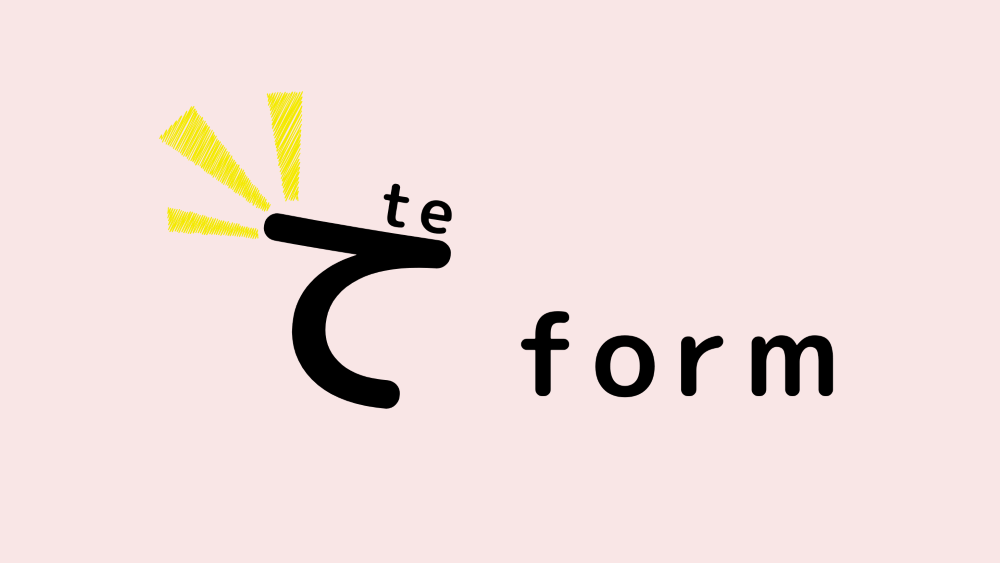The te-form (て form) is one of the most important and versatile verb forms in Japanese. If you master it early on, it will definitely help you when learning more advanced grammar later on!
If you have never studied Japanese verbs yet, start with the page below!
Japanese Te-form Conjugation
U-verbs (Group 1)
These are divided into five patterns depending on the final syllable of the verb in its dictionary form:
Examples:
- 書く → 書いて
“kaku” → “kaite” - 話す → 話して
“hanasu” → “hanashite” - 飲む → 飲んで
“nomu” → “nonde”
⚠️There is only one exception
- 行く → 行って
“iku” → “itte”
Ru-verbs (Group 2)
Examples:
- 食べる → 食べて
“taberu” → “tabete” - 見る → 見て
“miru” → “mite” - 寝る → 寝て
“neru” → “nete”
Irregular Verbs (Group 3)
There are two irregular verbs in Japanese, which is “する” and “くる.”
- する → して
“suru” → “shite” - 来る → きて
“kuru” → “kite”
Te-form Usage Patterns by Level
Beginner Level
〜ています (Ongoing action / State)
Examples:
日本語を勉強しています。
I am studying Japanese.
私は東京に住んでいる。
I live in Tokyo.
〜てください (Request)
Examples:
ここに書いてください。
Please write here.
こちらに来てください。
Please come here.
〜てから (Sequence of actions)
Examples:
手を洗ってから食べましょう。
Let’s eat after washing our hands.
食べてから薬を飲みます。
I will take the medicine after eating.
〜て、〜て (Multiple actions)
Examples:
好きなだけ食べて飲んで歌ってください。
Please eat, drink, and sing as much as you like.
顔を洗って、朝ごはんを食べて、出かけました。
I washed my face, ate breakfast, and went out.
〜てもいい / 〜てはいけない (Permission / Prohibition)
Examples:
部屋に入ってもいいですよ。
You may enter the room.
ここでタバコを吸ってはいけません。
You must not smoke here.
Intermediate Level
〜ているところ (At the moment of doing something)
Examples:
彼は電話をしているところです。
He is just making a phone call.
本を読んでいるところです。
I’m reading a book right now.
〜て + sentence (Reason / Cause)
Examples:
電車が遅れて、困りました。
The train was delayed, so I had a problem.
雨が降って、イベントは中止になりました。
It rained, so the event was cancelled.
〜てしまう (Completion / Regret)
Examples:
宿題を忘れてしまいました。
I accidentally forgot my homework.
急がないと、電車に乗り遅れてしまいます。
If I don’t hurry, I’ll miss the train.
〜てみる (Try doing something)
Examples:
一緒にやってみましょう。
Let’s try it together.
この靴を履いてみませんか?
Would you like to try wearing these shoes?
〜てある (Resulting state)
Examples:
部屋はきれいに片づけてあります。
The room has been neatly cleaned up.
鍵は机に置いてあります。
The key has been placed on the desk.
〜ておく (Preparation)
Examples:
書類をチェックしておきます。
I’ll check the documents in advance.
レッスンの前に読んでおいてください。
Please read it before the lesson.
〜ても、〜ても (Even if… / Even if not)
Examples:
覚えても覚えても、また忘れてしまいます。
Even though I memorise it again and again, I keep forgetting.
来ても来なくても同じです。
Whether you come or not, it’s the same.
Advanced Level
〜てみせる (Strong determination)
Examples:
今度こそ100点をとってみせるよ!
This time, I’ll get a perfect score for sure!
あなたの信頼を取り戻してみせます。
I’ll win back your trust—just watch me.
~ては、〜ては (Repetitive actions)
Examples:
あの人は立っては座り、座っては立ちを繰り返している。
That person keeps standing up and sitting down again and again.
食べては寝て、飲んでは寝てばかりしていると太りますよ。
If you just keep eating and sleeping, and drinking and sleeping, you’ll gain weight.
〜てでも (Determined despite difficulty)
Examples:
無理してでも行かなければならない。
I have to go, even if it’s too much for me.
お金を借りてでも留学したいです。
I want to study abroad, even if I have to borrow money.
〜てこそ (Only when / Only after)
Examples:
大人になってこそ、責任の重さが理解できる。
Only when you become an adult can you understand the weight of responsibility.
挑戦してこそ、男だろ!
You’re only a man when you take on a challenge!
As we’ve seen, the Japanese te-form has many uses and is an essential and versatile grammatical structure. Start by memorising the conjugation, then gradually build your understanding from basic to advanced usage.



